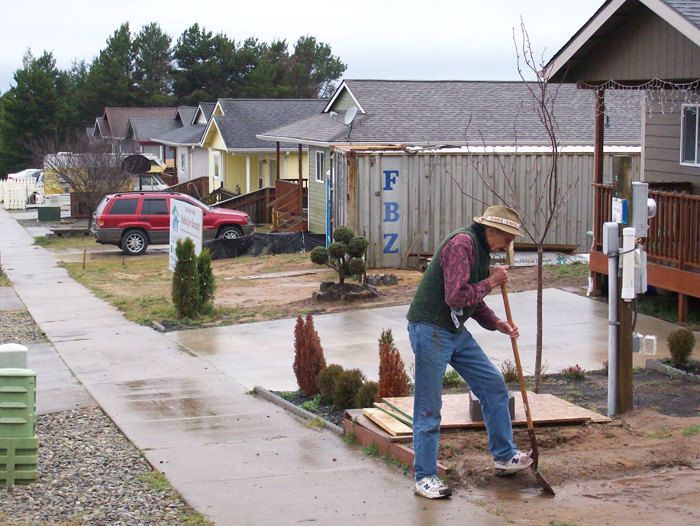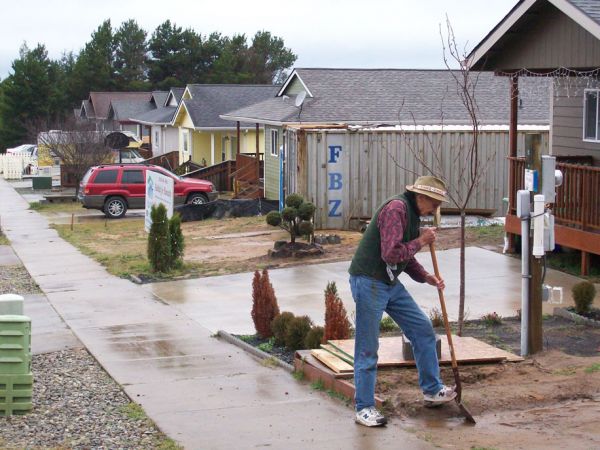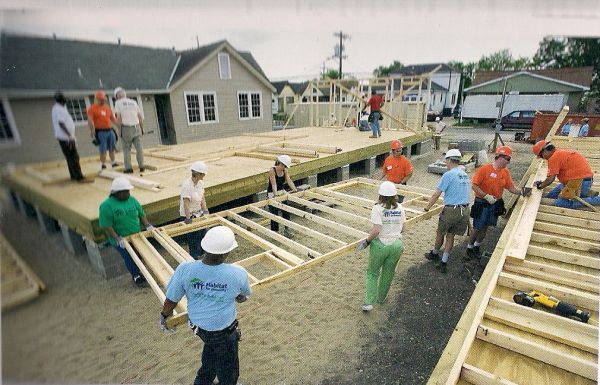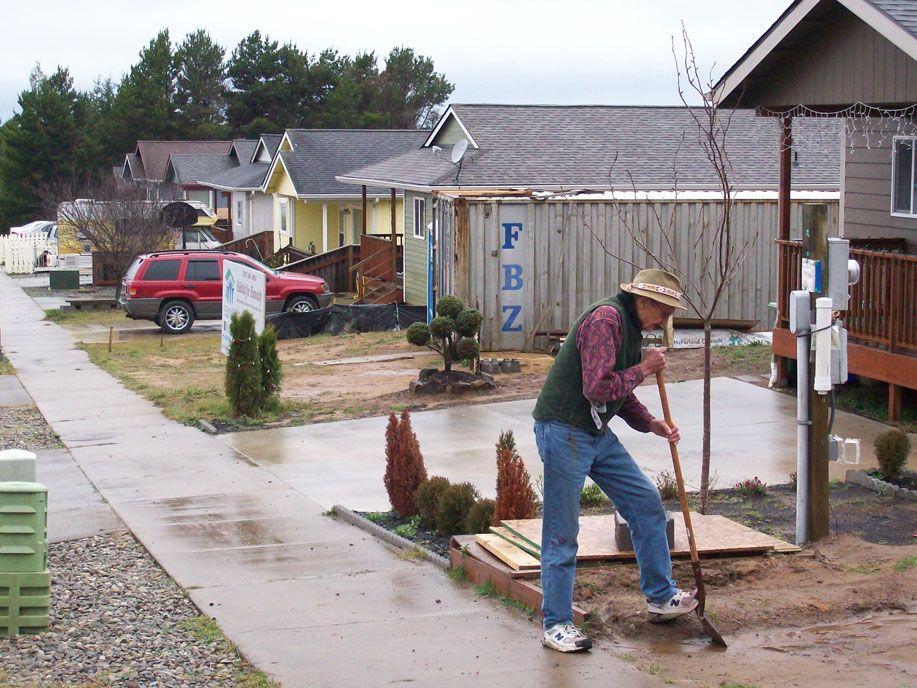
The Habitat House
“No social system will bring us happiness, health, and prosperity unless it is inspired by something greater than materialism.”
—Clement Attlee
In the mid-1990s, I recall listening to a radio program about a Children’s Bill of Rights. Children from around the world had sent in letters offering suggestions for this program. One letter in particular grabbed my attention and remains vivid in my memory. A 14-year-old boy wrote, “Every child should have a blanket and a place to lie down and sleep!”
The last time I was in the Philippines was 1998. I read in their main newspaper, The Manila Times, that 25,000 abandoned children were living on the city streets and scrounging for food in landfills. I have walked these streets and the streets of other cities and seen groups of children huddled together, sleeping in doorways without a blanket in sight—throwaway children. A recent census in Los Angeles found more than 90,000 people living on the streets of that city. Many of these are parents with children, real children with their own hopes and dreams!
These are our children homeless on our streets. There are thousands of them! It’s a strange world we live in where dogs and cats often receive better treatment than children. Welcome to America! Let’s go shopping. Blessed are those who care for others.

Habitat builds for people not profit.
Habitat for Humanity is a nonprofit organization that works to care for others and provide sleeping places for both adults and children. They do their best, but they are losing ground. Many families, including children, fall through the cracks in our system—a system where, as they say, profit rules. The trouble with the profit system these days is that it seems to be profitable only for a few.
The need for decent, affordable housing in this country and throughout the world continues to increase. This is especially true as 83 million new people are added to this planet every year. Every one of these new human beings needs food, water, a blanket, and a place to sleep. Millions of families in our country spend over one-third or even one-half of their income on housing alone. I know middle-class families with steady incomes who work and struggle first to purchase a home and then to make their mortgage payments on time. Money that used to go toward medical care, food, and a child’s education is now spent so families can keep a roof over their heads.
Since coming to Oregon 14 years ago, I have helped build 20 Habitat houses here in our community. All across this country and in many other countries, people like you and me are working with our neighbors to build affordable housing with needy families. Habitat is not a giveaway program; rather, it offers people a “hand up, not a handout.” So in addition to taking on an interest-free mortgage, the new homeowners have to put in 500 hours of “sweat equity,” working with us volunteers to help build their home. Because we work with mainly volunteer labor from all walks of life—men, women, young and old, skilled and unskilled—we are able to build these houses for about $60,000, including land. This results in a mortgage that even low-income families can handle. (Land is more expensive in the cities, which makes mortgage payments higher.)

Habitat volunteers come from all walks of life.
A Habitat house, or any decent house, needs to be built so it doesn’t leak either water or air. We take care to ensure that there are no holes under the siding that could let in moist air—which can cause mold and rot, compromising both health and home—and increase energy use. All walls are covered with 4×8 sheets of oriented strand board (OSB) and 30-lb. felt paper before the siding is installed. Further care is taken to ensure that these new houses are not full of toxic fumes, which can come from paint, carpet, and a host of other common, seemingly innocuous materials. We work to make the home energy efficient, well ventilated, and comfortable, and we use safe, health-preserving materials that require a minimum of upkeep and maintenance. We try to build from forest products and other materials that are renewable and sustainable so that we don’t lay further waste to our homeland. Anyone building a decent, affordable house can do this. What it takes is a desire to learn, a willingness to be helpful, and the energy to make a difference. That is what we volunteers working with Habitat for Humanity try to do.
One of the joys of building a Habitat house is that you get to work with and know a new family. We build more than houses. We develop close friendships as we work side by side, taking breaks together, and sharing our stories. I will let the story of a young teenager, Ashley, tell you what I mean by this: “Contrary to what people may think, having a lot of brothers is not always fun. I know. I am the only girl in a family with six children. We used to live in a small house with two bedrooms. My parents and baby brother slept in one of the bedrooms. The other bedroom was for my four older brothers and me.” How can “girls rule” when living like this?
A big part of building an affordable house is to build small. Habitat houses are around 950 sq. ft. for a two-bedroom and 1,100 sq. ft. for a three-bedroom. Do we really need our bedrooms to be the size of a discotheque? It is great to dance, but usually, though not always, we go to our bedrooms to sleep for eight hours.
Unlike these small Habitat houses, the trend in our country has been away from affordable housing. I have heard real-estate agents and bank officials advise clients to build large because it will increase the resale value of their house. So we wind up building a house either to inflate our egos or to see if we can make a profit. We somehow have gotten away from building what our family really needs.
In areas where the local city codes will allow it, as in our city, Habitat doesn’t build a garage. The organization puts it simply, “We build for people, not cars.” This, of course, reduces the total cost and makes the mortgage lower. On the other hand, off-street parking is provided.

Is happiness a full garage?
Garages are mainly used to store stuff most of us really don’t need. A Habitat home doesn’t come with lots of storage other than closets. We trim the closets in our houses with little more than just a shelf and pole to add some storage space. Hopefully this minimal storage space is an encouragement for homeowners to do something with their lives other than shop.
There is a natural rhythm to all, and we can enter that space which is really not outside ourselves. It is important not to neglect our inner lives, to do what it takes to bring us closer to the deepest and best part of ourselves. We always hope that living in their own home built by us volunteers will help Habitat families find this space.
As theologian Howard Thurman put it, “Don’t ask what the world needs. Ask what makes you come alive, and go do it. Because what the world needs are people who have come alive.”
Fine Homebuilding Recommended Products
Fine Homebuilding receives a commission for items purchased through links on this site, including Amazon Associates and other affiliate advertising programs.

8067 All-Weather Flashing Tape

Handy Heat Gun

Affordable IR Camera






























View Comments
Habitat also provides sometype of out building or shed don't they?
Not many builders realize this but the health effects of a bad water leak decades ago, which might have been painted over, etc, or lead dust, can persist for a very long time.
24% of us need to be especially careful.. Thats the percentage of us who can't eliminate mold toxins from our systems fast enough to avoid illness when we get exposed to a lot of it. So in very serious flooding events like some towns in Hurricane Katrina's aftermath, the number of the people who were there who got ill was consistently 24%. ...
It only takes one exposure like that to make you hypersensitive to mold for the whole rest of your life. Then you get sick at the drop of a hat. Your body remembers the threat.
You only get one immune system.
Once a wall has been wet at over 99% RH and stayed that way for more than 3 or 4 days, its gotten moldy, even if it dries out, if there was visible mold, it's very likely still potentially dangerous and has to be cleaned out.
No magic formulas, not even most recipes that use heavily diluted bleach
can deactivate them with a wipe or two.. The toxic stachybotrys toxins are even stable at a 500 degree temperature. Hotter than most ovens. Ask the military!
Sodium hydroxide in water, if its very strong and left on a long time (>15 minutes) scrubbing with wire brushes is necessary too. can remove mold effectively from semiporous materials like solid wood. But moldy sheetrock is not really cleanable. It should be removed and replaced.
With all porous materials, really there isn't any safe choice rather than throwing them out. That includes clothes, books, open cell foam..
Be careful.
The best thing someone working in a site with mold can do is wear a HEPA particulate filter mask and gloves all the time..The low molecular weight mycotoxins that mold manufactures to kill other molds, are capable of absorbing through your skin, just like water. And they do, they go right into the bloodstream, bypassing the portal circulation and the liver.
You don't want to end up like those homeless people you mentioned, sick, not knowing why, unable to do simple math or even (Ive seen this happen) respond normally to your own name.
christopher99
Thanks for that helpful comment. I found it very informative. I have a blog on this subject that I will post in a few weeks. Toxins anywhere including the job site need to be taken seriously. I learned this the hard way.
Here in Coos Bay we do build a shed for Habitat owners---8x10 shed where they can store stuff.
Larry Haun
It's very easy to say something is wrong, and even easier to simply infer a criticism without actually saying anything. It's a lot harder to be correct.
Let's look at those 'homeless' numbers. As the numbers are tabulated, anyone living in a weekly hotel is counted as 'homeless.' By this standard, General Douglas McArthur was homeless, as he paid weekly rent for his suite at the Waldorf-Astoria. Plenty of folks with steady income live for years in weekly or SRO hotels. Whatever else they are , these folks are NOT homeless, nor are they 'on the streets.'
Not that it matters. "Habitat" -or any other such group- isn't about to build a home for a single man or childless couple anyway.
Why should "Habitat" be building any houses? A visit to the HUD site ( hudhomestore.com ) will produce plenty of vacant, ownerless homes. If you want to save resources- how about using the homes we've already built?
The author is perfectly free to offer his opinions about housing. Yet, I see nothing that entitles him to make these choices (size, design, etc.) for anyone else.
Materialism? Without 'private property' you have neither rights nor prosperity. Whatever the faults of our past century have been, our way has lifted even the poorest of us from midieval hovels to palaces even Caesar would envy. Only in America do the 'poor' drive their own cars to protest marches.
Then again, I am only inferring that the author has a problem with American society, its' traditions, and its' values. His opening quote from a socialist politician and further comments regarding placing people ahead of profit may have misled me in my conclusions.
Reno,
Thanks for the thoughtful comment.
Yes, These blogs are my opinions. And you know what? Often I am wrong.
A question for you if you don't mind....Is, to use an over used word, the life we have built for ourselves sustainable. Where do we go from here on this planet with dwindling resources?
I think maybe the biggest boon that Habitat offers us is that volunteers often learn some good building skills and working with others draws a community together.
Mainly I post these blogs for people like you---hoping to give others a chance to think and comment.
Sustainable. What a word, what a concept. wWell, it's been raised before, many times ..... with proofs of irrefutable logic, precise math, and by some of the best educated. These luminaries were also all wrong.
Britain's "White Paper" of the 30's proved that greater Palestine was already overpopulated, and could not possibly support continued Jewish immigration. Yet, somehow, a minor part of that same land today supports a population twenty times as great, and at an infinitely higher standard of living.
More recently, Paul Ehrlich ("The Population Bomb," in the 70's) cited the inevetability of famine and the collapse of civilisation as populations grew. His population projections were seriously low - yet his 'certain' disaster is already decades late.
Thus, I conclude that advocates of 'sustainability' have not a clue to the way nature operates. It's a bankrupt concept.
Let's look at the other side of the coin: What of the places that have taken paths that stressed the 'common good' at the expense of liberty? Every one has declined. Some have redefined the concept of Hell. China and India, who were once scenes of endless calamity, are today prospering in direct relation to the extent that they have shed collectivist practice.
Imagine that .... countries that had millennia of a 'head start' in development having to 'catch up' with us - we, who were but a colonial backwater 250 years ago.
Perhaps even the Middle East would find peace, were they to listen to '72 Virginians,' rather than dream of '72 virgins.'
Reno,
Or even 72 sturgeons as us NW people think. Thanks, Reno for your thoughtful posts. Larry Haun
I have helped out with my local HFH builds and I find that they homes that are built are soon trashed and not respected by those who live in them. Its disgraceful and I have stopped helping out.
I had realized that the easiest thing to do in life is to criticize, either for or in con, its just a matter of saying something, but to actually get up and live up the way I talk is something completely different. I am grateful that there is people in the world that still cares for the well being of others, and not just want to make a buck out of people's needs.
Habitat in our 2 counties in western N.C. build a shed to store our tools while we are working. After the home is done and dedicated it is then a storage shed for the family to keep lawn mower and other tools out of the weather.
Our crew is called the Wednesday Crew we meet once a week we are mostly retired guys to old to hire out but still with some skills. We build 2 houses a year and the good feeling you get when the house is dedicated and the family takes the keys is worth all your labor. The wives of the crew members make quilts for each family member.Our crew with our wives go out for dinner once a month so there are some perks.
I would highly recomend getting a crew together and joining Habitat give it a try we have been together for 8 yrs and are getting older but stronger.
As a Georgian, I'm proud of Pres. Carter and what he has done w/ HFH. But I agree with the earlier commenter, with boarded up, dilapidated houses throughout our cities, HFH needs to shift gears and renovate, not build.
SitUboo,
I appreciate your comment. I know that Habitat has looked into this but not sure if they have had success or not. Problem seems to be these thousands and thousands of houses are owned by banks and insurance companies. Any ideas as to what to do with that blockade? Larry Haun
Several years ago, I had the pleasure of sitting in Larry Haun's home in Coos Bay and discussing post Katrina New Orleans (my home). I found him to be a profoundly kind and gentle soul. We talked of things from Hummingbirds to affordable housing, trekking in South America and responsibilities toward our fellow man. You see, Mr Haun was my teacher through his many videos and books. Without knowing me, he helped launch my business as a contractor! He is greatly missed through his publications and his example.